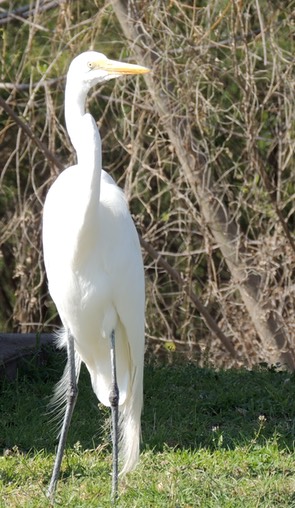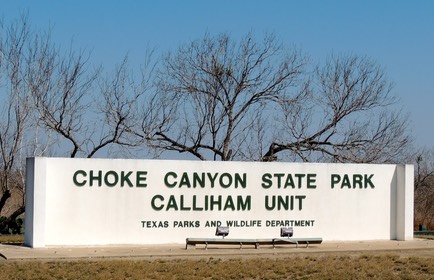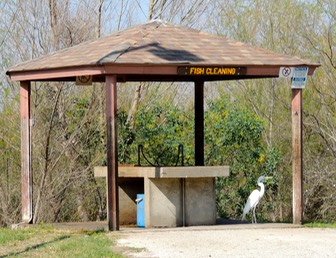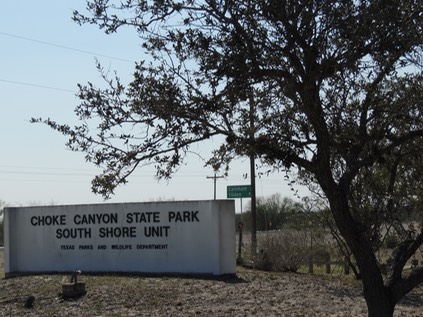CHOKE CANYON STATE PARK
Published in the La Vernia News on April 3, 2014
Spot alligators, alligator gar


Choke Canyon State Park offers tent campsites, as well as screened shelters, and campsites with water and electricity
Choke Canyon Dam created a man-made 26,000-acre reservoir to supply water to the city of Corpus Christi. Construction of the dam began in 1978, was slightly delayed by Hurricane Allan, and substantially complete in May1984. Low-lying hills force the waters of the Frio, Nueces, and Atascosa Rivers into a constricted channel, thus the name, Choke Canyon. The Frio River is the primary inflow of water; the maximum depth of the reservoir is 95 feet.
Even before the dam was completed, the Choke Canyon State Park was created thanks to a 50-year cooperative agreement between the Bureau of Reclamation, the City of Corpus Christi, and the Nueces River Authority. Two separate areas comprise the park: the South Shore Unit, opened to the public in 1986 and the Calliham Unit in 1987. Choke Canyon State Park is located 89 miles from LaVernia, near the small town of Three Rivers.
A long, long time ago...
This land was formed by accumulating sediments from seas that once covered south Texas during the period following the extinction of the dinosaur. In fact, Choke Canyon Dam is near the ancient Gulf shoreline of 30 million years ago. There is also evidence that the Paleo Indians crossed the Frio River Valley more than 10,000 years ago. They were hunters and most likely were following herds of bison and mammoth. Stone artifacts such as dart points used at the end of spears for hunting, dating between 10,000 years and 1,000 years ago, have been found in this area. Pottery, stone tools, basketry and gourd vessels were also found from later periods during archeological research in the canyon prior to completion of the dam.
Everyday Journeys
Harry and Linda Kaye Perez
In the park
The 385-acre South Shore Unit is for day-use only (no overnight camping) and offers a six-lane boat ramp, a fish cleaning station, picnic areas, hiking, birding, and wildlife viewing. The larger Calliham Unit (1,100 acres in size) has hiking and birding trails, a wildlife educational center, basketball and tennis courts, softball and volleyball areas, and bathrooms with showers. There are 40 campsites equipped with water and electricity; 20 brick-tile screened shelters with electricity and air conditioning; and 15 tent sites surrounding what is known at the 75 Acre Lake. The Calliham Unit also has a six-lane boat ramp; water sports include boating, swimming and waterskiing.

To see and to do
Wildlife within the park includes wild turkey, white-tailed deer, javelina, coyote, opossum, fox squirrel, raccoon and, yes, skunks. Choke Canyon is the site of the westernmost common occurrence of the American Alligator, as evidence by the many signs: “Beware-Alligators exist in this Park.”
Birding is excellent here, especially in the Calliham Unit. Year-round residents include Double-crested Cormorants, Great Egrets, Crested Caracara, Northern Bobwhite, Killdeer, and Mourning Doves just to name a few. Winter brings Orange-crowned Warblers, Vermilion Flycatchers, and Sandhill Cranes. If you are a birdwatcher, be sure to pick up the Birds of Choke Canyon Checklist available free at the Park Headquarters, and also check for their seasonal guided bird walks.

Fishing is probably the most popular activity at Choke Canyon State Park and includes largemouth and white bass, blue, channel and flathead catfish, sunfish, crappie and alligator gar. The best part is that no fishing license and stamp is required if you fish within the boundaries of any Texas State Park.
We visited in early March; the grasses had not turned green yet and there were no wildflowers to color the landscape. We could just image how beautiful the park will be after a much needed spring rain.
Choke Canyon State Park: (361) 786-3868
http://www.tpwd.state.tx.us/state-parks/choke-canyon
Texas State Park Pass Information:
http://www.tpwd.state.tx.us/spdest/parkinfo/passes/

TIDBITS: An Annual Texas State Park Pass, ($70) allows the holder and guests to enjoy unlimited visits to any Texas State Park without paying the daily entrance fees.
A Texas Parklands Passport offers free or reduced entry fees for Texas residents over 65, certain veterans and disabled persons. There is no cost for this pass. Check the Texas State Parks website for documents you might need to acquire this pass.
The Texas State Park Geochache Challenge: At last check, there were three caches hidden at Choke Canyon State Park.
Currently, the water level in the reservoir is down and the park recommends putting in boats at the Calliham ramps instead of the South Shore ramps.
FEES (without park pass)
Entrance Fees: $5 per day per person (13 years or older)
Tent sites: $12 per day plus entrance fee
Campsites with water/electricity: $22 per day plus entrance fee
Shelters with air conditioning: $50 per day plus entrance fee